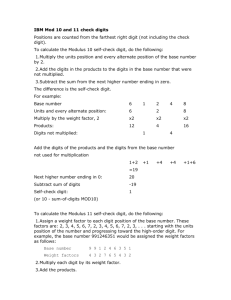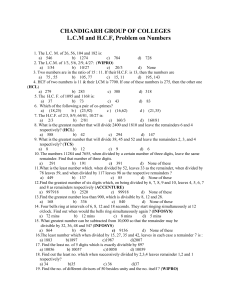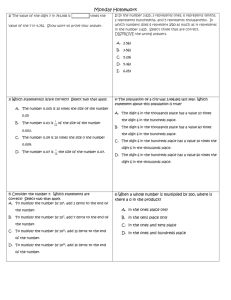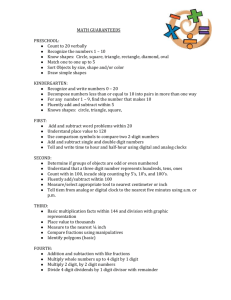Number Sense Tricks
advertisement
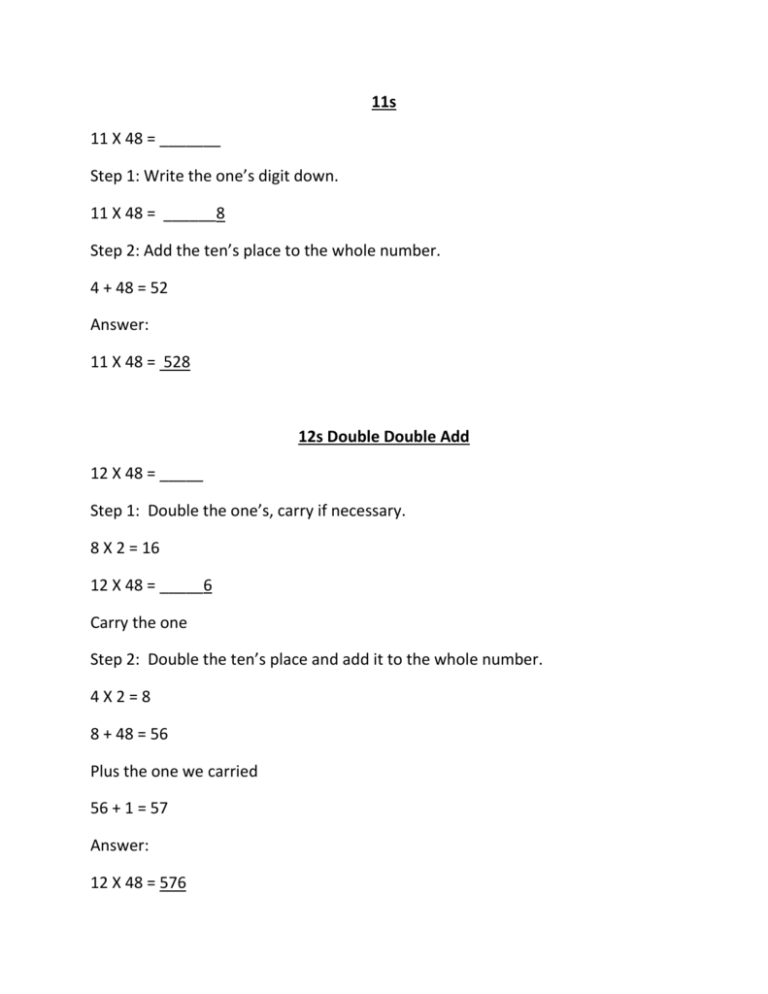
11s 11 X 48 = _______ Step 1: Write the one’s digit down. 11 X 48 = ______8 Step 2: Add the ten’s place to the whole number. 4 + 48 = 52 Answer: 11 X 48 = 528 12s Double Double Add 12 X 48 = _____ Step 1: Double the one’s, carry if necessary. 8 X 2 = 16 12 X 48 = _____6 Carry the one Step 2: Double the ten’s place and add it to the whole number. 4X2=8 8 + 48 = 56 Plus the one we carried 56 + 1 = 57 Answer: 12 X 48 = 576 General Multiplication 43 X 7 = ______ Decompose larger number into two parts – 40 and 3 40 X 7 = 280 3 X 7 = 21 Add both answers together 280 + 21 = 301 Extension: They may add a zero to one of the numbers. Follow the same procedure and add an extra zero to the answer. 1) 2) 3) 4) 5) 43 X 70 40 X 7 = 280 3 X 7 = 21 280 + 21 = 301 43 X 70 = 3,010 Combinations 5 X 7 X 6 = ________ First multiply the two numbers that have a product ending in zero. 5 X 6 = 30 Then multiply the product by the remaining number. 30 X 7 = 210 Remember, you just multiply 3 X 7 = 21 and then add the zero. 30 X 7 = 21 25s Divide by 4 25 X 36 Step 1: Divide number by 4 36 ÷ 4 = 9 25 X 36 = _9___ Step 2: If there is no remainder, add two zeros 25 X 36 = 900 If the remainder is one, add 25 25 X 37 = 925 If the remainder is two, add 50 25 X 38 = 950 If the remainder is three, add 75 25 X 39 = 975 50s Divide by 2 50 X 36 Step 1: Divide number by 2 36 ÷ 2 = 18 50 X 36 = 18____ Step 2: If there is no remainder, add 2 zeros. 50 X 36 = 1,800 If the remainder is 1, add 50. 50 X 36 = 1,850 Reverses 973 – 379 Step 1: Subtract hundreds, minus one more. 9–3=6 Minus one more… 6–1=5 973 – 379 = 5_____ Step 2: Write a 9 973 – 379 = 59____ Step 3: The last digit and the first digit should add up to 9. Since the first digit is 5 and 5 + 4 = 9, the last digit is 4. 973 – 379 = 594 75s Divide by 4 times 3 75 X 36 Step 1: Divide the number by 4 36 ÷ 4 = 9 Step 2: Multiply the answer by 3 9 X 3 = 27 Add 2 zeros 75 X 36 = 2,700 Multiply Numbers Ending in 5 65 X 85 = Step 1: Multiply first two digits 6 X 8 = 48 Step 2: Average first two numbers (if after adding, answer is odd, subtract one) and add this to the previous number. 6 + 8 = 14 14 ÷ 2 = 7 7 + 48 = 55 65 X 85 = 55___ Step 3: If when you added the first two numbers, the answer was even, add 25, if the answer was odd, add 75 Since 6 + 8 = 14 Since 14 is even, we add 25 65 X 85 = 5,525 Example 2: 45 X 95 Step 1: 4 X 9 = 36 Step 2: 4 + 9 = 13 ÷ 2 = 6 remainder 1, ignore the remainder 6 + 36 = 42 Since 4 + 9 is odd, we add 75 45 X 95 = 4,275 With this method, it is easy to mix up the steps or leave one out resulting in an incorrect solution. Work through many example problems slowly and notice common mistakes you are making. Difference of Squares If you know the squares of a number, say 25 X 25 = 625, you can find the product of two numbers equally spaced from 25. Example 1: 24 X 26 Since 24 and 26 are both 1 away from 25, we take 1 X 1 = 1 and subtract from 625. Since 25 X 25 = 625 625 – 1 = 624 24 X 26 = 624 Example 2: 23 X 27 Since 23 and 27 are both 2 away from 25, we take 2 X 2 = 4 and subtract from 625. 625 – 4 = 621, therefore 23 X 27 = 621 Example 3: 16 X 24 Since 16 and 24 are both 4 away from 20, we take 4 X 4 = 16. Since 20 X 20 = 400, we subtract 16 from 400. 400 – 16 = 384, therefore 16 X 24 = 384 Double-Half Method 14 X 15 Sometimes it’s easier to multiply half of one number times double of the other. 7 X 30 = 14 X 15 Since 7 X 30 = 210 Then 14 X 15 = 210 Example 2: 22 X 45 11 X 90 = 990, therefore 22 X 45 = 990 Example 3: 16 X 35 8 X 70 = 560, therefore 16 X 15 = 560 *Difference of Squares and Double-Half Method Problems look very similar, the key is learning to distinguish quickly between them and applying the correct technique* Remainders: Remainders dividing by 3 Find the remainder of 2572 ÷ 3 Add each digit 2 + 5 + 7 + 2 = 16 Keep adding until you get a single digit 1+6=7 Divide the single digit by 3 7 ÷ 3 = 2 remainder of 1 So 2572 also has a remainder of 1 Remainders dividing by 4 Find the remainder of 1857 ÷ 4 Use only the last two digits when dividing by 4 57 ÷ 4 = 14 remainder of 1 So 1857 ÷ 4 also has a remainder of 1 Remainders dividing by 5 Multiples of 5 land on 0 or 5 so use only the last digit If last digit is zero or five, then remainder is 0 Examples: 1765, 15770, 287295 If last digit is less than 5 Examples: 3784, 28903, 20982 Then last digit is the remainder If the last digit is greater, then subtract 5 and you have the remainder Example: 19878 ÷ 5 8 – 5 = 3, so the remainder is 3 Remainder dividing by 9 Since 9 = 3 X 3, this trick is similar to the 3s Find the remainder of 2572 ÷ 9 Add each digit 2 + 5 + 7 + 2 = 16 Keep adding until you get a single digit 1+6=7 The difference between 9s and 3s is that the last digit is the remainder So 2572 ÷ 9 has a remainder of 7 * If the single digit turns out to be 9, then there is no remainder* Squaring numbers ending in 5 65 X 65 = Multiply first digit by next number in the numer line. 6 X 7 = 42 All answers end in 25 65 X 65 = 4225 Example 2 35 X 35 = ? 3 X 4 = 12 35 X 35 = 1225 Advanced Tricks: Estimating by 111 (This is like 11s) 2-digit numbers 76 X 111 = ? Add the first digit to the whole number, write this number down. 7 + 76 = 83 76 X 111 = 83 Now add two zeros 76 X 111 = 8300 This will provide an answer within the acceptable range for number 11-111. The only number that the estimate is too low for is 19. Estimating 111 by 3 or more digits 716 X 111 = ? Add the first digit to the first two, write this number down. 7 + 71 = 78 716 X 111 = 78 After first two digits, write the remaining digits you have not used and add 2 zeros. 716 X 111 = 78600 Example 2: 111 X 1428 = ? Add first digit to the first two, write this number down. 1 + 14 = 15 After first two digits, write the remaining digits you have not used and add 2 zeros. 111 X 1428 = 152800 Estimating 125s 125 X 32 = ? This is like 25s, except we divide by 8 since 8 X 125 = 1000, and we add three 0s instead of two. 32 ÷ 8 = 4, therefore 125 X 32 = 4000 Example 2: 125 X 34 = ? If there is a remainder, use this as the next number in place of a zero. 34 ÷ 8 = 4 remainder 2 therefore 125 X 34 = 4200 Example 3: 125 X 139 = ? 139 ÷ 8 = 17 remainder 3, therefore 125 X 139 = 17300




